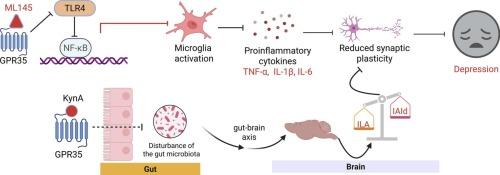From orphan receptor to inflammation regulation: The role of GPR35 in the pathogenesis of depression
IF 5.6
2区 医学
Q1 PHARMACOLOGY & PHARMACY
引用次数: 0
Abstract
G protein-coupled receptors (GPCRs) constitute the largest family of membrane receptors and have attracted significant attention as pharmacological targets, and they represent the largest target class for many drugs used in the treatment of various diseases. One of the intriguing members of this family is G protein-coupled receptor 35 (GPR35), which belongs to the class A GPCR superfamily and is an orphan receptor. GPR35 has been shown to be expressed in many organ-tissue systems, including the gastrointestinal tract, immune system, and central nervous system (CNS). Therefore, its association with the progression of pathophysiological diseases in these organ-tissue systems is not surprising. Accumulating evidence has implicated GPR35 in the regulation of inflammatory responses. Additionally, GPR35 has been demonstrated to be involved in depression-like behaviours induced by inflammation in mice. Despite these findings, the precise mechanisms by which GPR35 contributes to the pathogenesis of depression remain unclear. In this article, we highlight the structure, widespread expression, and endogenous ligands of GPR35, as well as its role in the pathophysiology of mental disorders, particularly in depression. In addition, we explored the role of GPR35 agonists and antagonists in the antidepressant mechanism, expanding the potential therapeutic value of GPR35 in depression. In summary, GPR35 has shown clear preclinical potential in the treatment of depression, which will provide a theoretical basis for accelerating its translation from the laboratory to the clinic, holding promise as a new breakthrough in the treatment of mental disorders.

从孤儿受体到炎症调节:GPR35在抑郁症发病机制中的作用。
G蛋白偶联受体(gpcr)是膜受体中最大的家族,作为药理靶点备受关注,是治疗多种疾病的许多药物中最大的靶点类别。这个家族中一个有趣的成员是G蛋白偶联受体35 (GPR35),它属于A类GPCR超家族,是一个孤儿受体。GPR35已被证明在许多器官组织系统中表达,包括胃肠道、免疫系统和中枢神经系统(CNS)。因此,它与这些器官-组织系统的病理生理疾病进展的关联并不奇怪。越来越多的证据表明GPR35参与炎症反应的调节。此外,GPR35已被证明参与小鼠炎症诱导的抑郁样行为。尽管有这些发现,GPR35参与抑郁症发病机制的确切机制仍不清楚。在这篇文章中,我们重点介绍了GPR35的结构、广泛表达和内源性配体,以及它在精神障碍,特别是抑郁症的病理生理中的作用。此外,我们探索了GPR35激动剂和拮抗剂在抗抑郁机制中的作用,拓展了GPR35在抑郁症中的潜在治疗价值。综上所述,GPR35在治疗抑郁症方面已显示出明显的临床前潜力,这将为加快其从实验室向临床的转化提供理论基础,有望成为治疗精神障碍的新突破。
本文章由计算机程序翻译,如有差异,请以英文原文为准。
求助全文
约1分钟内获得全文
求助全文
来源期刊

Biochemical pharmacology
医学-药学
CiteScore
10.30
自引率
1.70%
发文量
420
审稿时长
17 days
期刊介绍:
Biochemical Pharmacology publishes original research findings, Commentaries and review articles related to the elucidation of cellular and tissue function(s) at the biochemical and molecular levels, the modification of cellular phenotype(s) by genetic, transcriptional/translational or drug/compound-induced modifications, as well as the pharmacodynamics and pharmacokinetics of xenobiotics and drugs, the latter including both small molecules and biologics.
The journal''s target audience includes scientists engaged in the identification and study of the mechanisms of action of xenobiotics, biologics and drugs and in the drug discovery and development process.
All areas of cellular biology and cellular, tissue/organ and whole animal pharmacology fall within the scope of the journal. Drug classes covered include anti-infectives, anti-inflammatory agents, chemotherapeutics, cardiovascular, endocrinological, immunological, metabolic, neurological and psychiatric drugs, as well as research on drug metabolism and kinetics. While medicinal chemistry is a topic of complimentary interest, manuscripts in this area must contain sufficient biological data to characterize pharmacologically the compounds reported. Submissions describing work focused predominately on chemical synthesis and molecular modeling will not be considered for review.
While particular emphasis is placed on reporting the results of molecular and biochemical studies, research involving the use of tissue and animal models of human pathophysiology and toxicology is of interest to the extent that it helps define drug mechanisms of action, safety and efficacy.
 求助内容:
求助内容: 应助结果提醒方式:
应助结果提醒方式:


